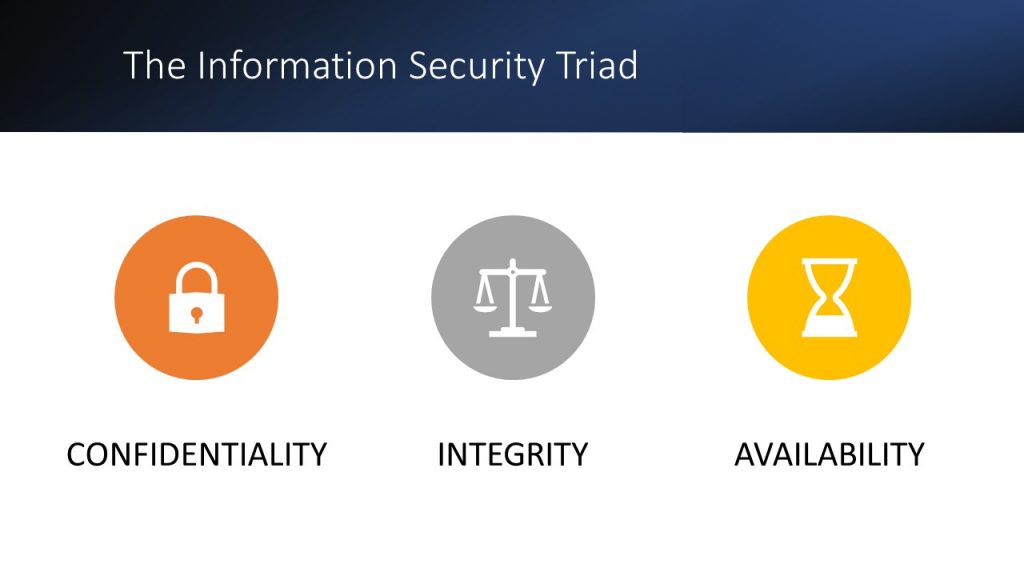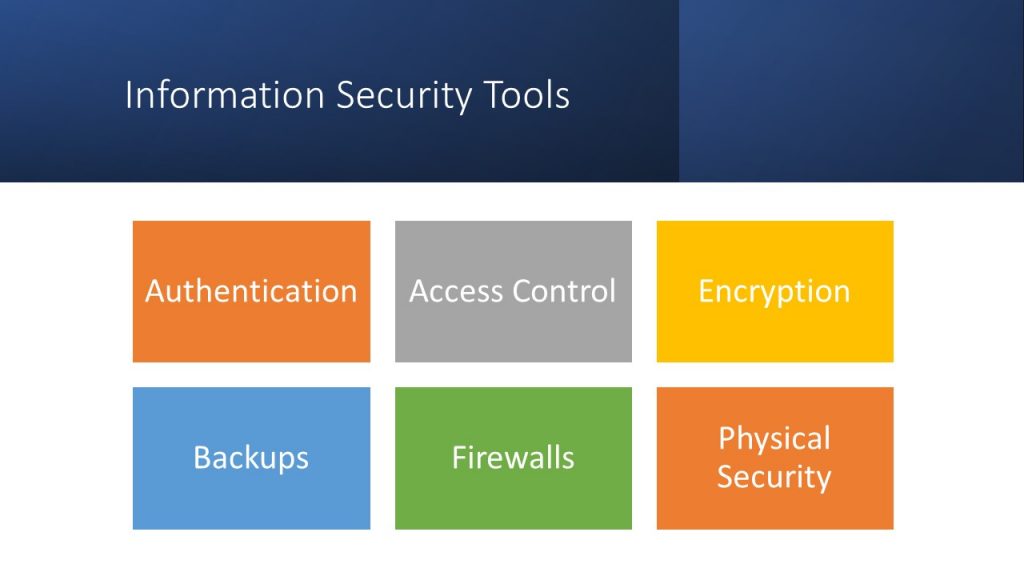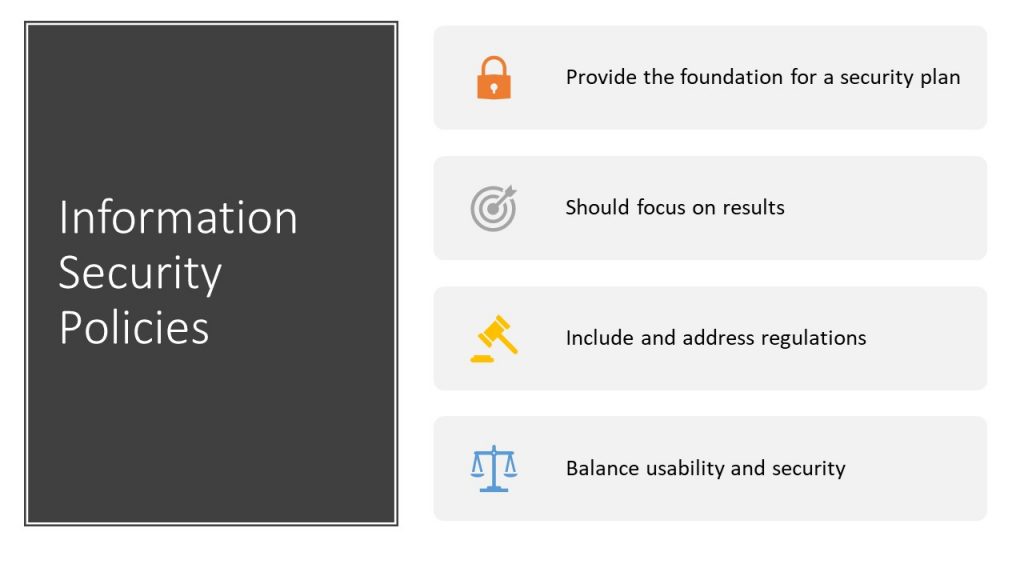4 Chapter 4 – Information Security
Learning Objectives
The information security triad: Confidentiality, Integrity, Availability (CIA)
When protecting information, we want to be able to restrict access to those who are allowed to see it; everyone else should be disallowed from learning anything about its contents. This is the essence of confidentiality. For example, federal law requires that universities restrict access to private student information. The university must be sure that only those who are authorized have access to view the grade records.
Integrity is the assurance that the information being accessed has not been altered and truly represents what is intended. Just as a person with integrity means what he or she says and can be trusted to consistently represent the truth, information integrity means information truly represents its intended meaning. Information can lose its integrity through malicious intent, such as when someone who is not authorized makes a change to intentionally misrepresent something. An example of this would be when a hacker is hired to go into the university’s system and change a grade.
Integrity can also be lost unintentionally, such as when a computer power surge corrupts a file, or someone authorized to make a change accidentally deletes a file or enters incorrect information.
Information availability is the third part of the CIA triad. Availability means that information can be accessed and modified by anyone authorized to do so in an appropriate timeframe. Depending on the type of information, appropriate timeframe can mean different things. For example, a stock trader needs information to be available immediately, while a salesperson may be happy to get sales numbers for the day in a report the next morning. Companies such as Amazon.com will require their servers to be available twenty-four hours a day, seven days a week. Other companies may not suffer if their web servers are down for a few minutes once in a while.

Tools for information security
In order to ensure the confidentiality, integrity, and availability of information, organizations can choose from a variety of tools. Each of these tools can be utilized as part of an overall information-security policy, which will be discussed in the next section.

Authentication
The most common way to identify someone is through their physical appearance, but how do we identify someone sitting behind a computer screen or at the ATM? Tools for authentication are used to ensure that the person accessing the information is, indeed, who they present themselves to be.
Authentication can be accomplished by identifying someone through one or more of three factors: something they know, something they have, or something they are. For example, the most common form of authentication today is the user ID and password. In this case, the authentication is done by confirming something that the user knows (their ID and password). But this form of authentication is easy to compromise, and stronger forms of authentication are sometimes needed. Identifying someone only by something they have, such as a key or a card, can also be problematic. When that identifying token is lost or stolen, the identity can be easily stolen. The final factor, something you are, is much harder to compromise. This factor identifies a user through the use of a physical characteristic, such as an eye-scan or fingerprint. Identifying someone through their physical characteristics is called biometrics.
A more secure way to authenticate a user is to do multi-factor authentication. By combining two or more of the factors listed above, it becomes much more difficult for someone to misrepresent themselves. An example of this would be the use of an RSA SecurID token. The RSA device is something you have and will generate a new access code every sixty seconds. To log in to an information resource using the RSA device, you combine something you know, a four-digit PIN, with the code generated by the device. The only way to properly authenticate is by both knowing the code and having the RSA device.
Access control
Once a user has been authenticated, the next step is to ensure that they can only access the information resources that are appropriate. This is done through the use of access control. Access control determines which users are authorized to read, modify, add, and/or delete information. Several different access control models exist. Here we will discuss two: the access control list (ACL) and role-based access control (RBAC).
For each information resource that an organization wishes to manage, a list of users who have the ability to take specific actions can be created. This is an access control list, or ACL. For each user, specific capabilities are assigned, such as read, write, delete, or add. Only users with those capabilities are allowed to perform those functions. If a user is not on the list, they have no ability to even know that the information resource exists.
ACLs are simple to understand and maintain. However, they have several drawbacks. The primary drawback is that each information resource is managed separately, so if a security administrator wanted to add or remove a user to a large set of information resources, it would be quite difficult. And as the number of users and resources increase, ACLs become harder to maintain. This has led to an improved method of access control, called role-based access control, or RBAC. With RBAC, instead of giving specific users access rights to an information resource, users are assigned to roles and then those roles are assigned the access. This allows the administrators to manage users and roles separately, simplifying administration and, by extension, improving security.
Encryption
Many times, an organization needs to transmit information over the Internet or transfer it on external media such as a CD or flash drive. In these cases, even with proper authentication and access control, it is possible for an unauthorized person to get access to the data. Encryption is a process of encoding data upon its transmission or storage so that only authorized individuals can read it. This encoding is accomplished by a computer program, which encodes the plain text that needs to be transmitted; then the recipient receives the cipher text and decodes it (decryption). In order for this to work, the sender and receiver need to agree on the method of encoding so that both parties can communicate properly. Both parties share the encryption key, enabling them to encode and decode each other’s messages. This is called symmetric key encryption. This type of encryption is problematic because the key is available in two different places.
An alternative to symmetric key encryption is public key encryption. In public key encryption, two keys are used: a public key and a private key. To send an encrypted message, you obtain the public key, encode the message, and send it. The recipient then uses the private key to decode it. The public key can be given to anyone who wishes to send the recipient a message. Each user simply needs one private key and one public key in order to secure messages. The private key is necessary in order to decrypt something sent with the public key.
Backups
Another essential tool for information security is a comprehensive backup plan for the entire organization. Not only should the data on the corporate servers be backed up, but individual computers used throughout the organization should also be backed up. A good backup plan should consist of several components.
• A full understanding of the organizational information resources. What information does the organization actually have?
Where is it stored? Some data may be stored on the organization’s servers, other data on users’ hard drives, some in the cloud, and some on third-party sites. An organization should make a full inventory of all of the information that needs to be backed up and determine the best way back it up.
• Regular backups of all data. The frequency of backups should be based on how important the data is to the company, combined with the ability of the company to replace any data that is lost. Critical data should be backed up daily, while less critical data could be backed up weekly.
• Offsite storage of backup data sets. If all of the backup data is being stored in the same facility as the original copies of the data, then a single event, such as an earthquake, fire, or tornado, would take out both the original data and the backup! It is essential that part of the backup plan is to store the data in an offsite location.
• Test of data restoration. On a regular basis, the backups should be put to the test by having some of the data restored. This will ensure that the process is working and will give the organization confidence in the backup plan.
Besides these considerations, organizations should also examine their operations to determine what effect downtime would have on their business. If their information technology were to be unavailable for any sustained period of time, how would it impact the business?
Additional concepts related to backup include the following:
• Universal Power Supply (UPS). A UPS is a device that provides battery backup to critical components of the system, allowing them to stay online longer and/or allowing the IT staff to shut them down using proper procedures in order to prevent the data loss that might occur from a power failure.
• Alternate, or “hot” sites. Some organizations choose to have an alternate site where an exact replica of their critical data is always kept up to date. When the primary site goes down, the alternate site is immediately brought online so that little or no downtime is experienced.
As information has become a strategic asset, a whole industry has sprung up around the technologies necessary for implementing a proper backup strategy. A company can contract with a service provider to back up all of their data or they can purchase large amounts of online storage space and do it themselves. Technologies such as storage area networks and archival systems are now used by most large businesses.
Firewalls
Another method that an organization should use to increase security on its network is a firewall. A firewall can exist as hardware or software (or both). A hardware firewall is a device that is connected to the network and filters the packets based on a set of rules. A software firewall runs on the operating system and intercepts packets as they arrive to a computer. A firewall protects all company servers and computers by stopping packets from outside the organization’s network that do not meet a strict set of criteria. A firewall may also be configured to restrict the flow of packets leaving the organization. This may be done to eliminate the possibility of employees watching YouTube videos or using Facebook from a company computer.
Physical security
An organization can implement the best authentication scheme in the world, develop the best access control, and install firewalls and intrusion prevention, but its security cannot be complete without implementation of physical security. Physical security is the protection of the actual hardware and networking components that store and transmit information resources. To implement physical security, an organization must identify all of the vulnerable resources and take measures to ensure that these resources cannot be physically tampered with or stolen. These measures include the following.
• Locked doors: It may seem obvious, but all the security in the world is useless if an intruder can simply walk in and physically remove a computing device. High-value information assets should be secured in a location with limited access.
• Physical intrusion detection: High-value information assets should be monitored through the use of security cameras and other means to detect unauthorized access to the physical locations where they exist.
• Secured equipment: Devices should be locked down to prevent them from being stolen. One employee’s hard drive could contain all of your customer information, so it is essential that it be secured.
• Environmental monitoring: An organization’s servers and other high-value equipment should always be kept in a room that is monitored for temperature, humidity, and airflow. The risk of a server failure rises when these factors go out of a specified range.
• Employee training: One of the most common ways thieves steal corporate information is to steal employee laptops while employees are traveling. Employees should be trained to secure their equipment whenever they are away from the office.
Security policies
Besides the technical controls listed above, organizations also need to implement security policies as a form of administrative control. In fact, these policies should really be a starting point in developing an overall security plan. A good information-security policy lays out the guidelines for employee use of the information resources of the company and provides the company recourse in the case that an employee violates a policy.
According to the SANS Institute, a good policy is “a formal, brief, and high-level statement or plan that embraces an organization’s general beliefs, goals, objectives, and acceptable procedures for a specified subject area.” Policies require compliance; failure to comply with a policy will result in disciplinary action. A policy does not lay out the specific technical details, instead it focuses on the desired results.
A good example of a security policy that many will be familiar with is a web use policy. A web use policy lays out the responsibilities of company employees as they use company resources to access the Internet. A good example of a web use policy is included in Harvard University’s “Computer Rules and Responsibilities” policy.
A security policy should also address any governmental or industry regulations that apply to the organization. For example, if the organization is a university, it must be aware of the Family Educational Rights and Privacy Act (FERPA), which restricts who has access to student information. Health care organizations are obligated to follow several regulations, such as the Health Insurance Portability and Accountability Act (HIPAA).

Usability
When looking to secure information resources, organizations must balance the need for security with users’ need to effectively access and use these resources. If a system’s security measures make it difficult to use, then users will find ways around the security, which may make the system more vulnerable than it would have been without the security measures! Take, for example, password policies. If the organization requires an extremely long password with several special characters, an employee may resort to writing it down and putting it in a drawer since it will be impossible to memorize.
Chapter 4 Assignment
- Research current issues with Facebook/google (choose one or both) in regard to user privacy. Include at least 1 article and a link/citation to the article. Briefly summarize the article (s).
- First, take the side of Facebook/Google. What ‘rights’ do they have over user data posted to their systems? When would they ultimately cross the ethical line when they handle user data?
- Next, take the side of the user. What rights do users have over their data in the US? What rights in Europe?
- Finally, what do you believe should happen with user data in the near future? List at least one positive and negative outcome if your solution would be implemented.
Grading

